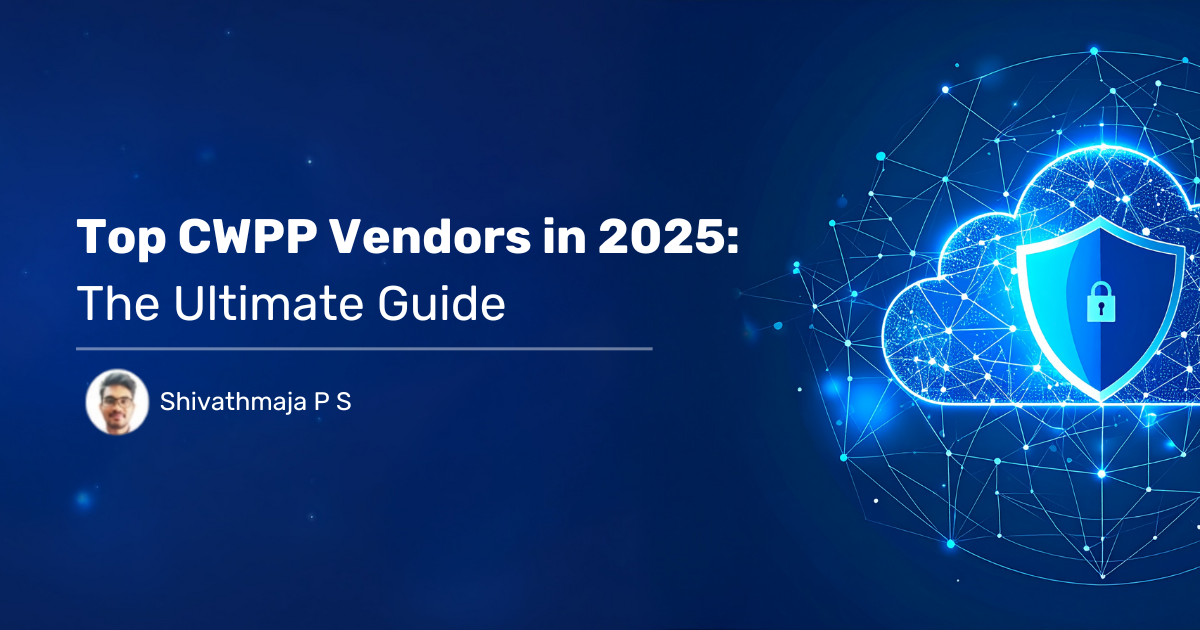Here’s a fun fact. Cloud Workload Protection Platforms (CWPPs) are no longer optional but essential. As cloud-native architectures grow more complex and cyber threats become more sophisticated, organizations are turning to CWPP solutions to lock down workloads across public, private, and hybrid cloud environments. But with so many options and vendors in the market, how do you choose one CWPP tool that works?
We’ve got you! In this definitive 2025 guide, we break down what CWPP is, which CWPP vendors are leading the charge, and what you should keep in mind to ensure you’re choosing the right tool for securing your cloud infrastructure.
What is a CWPP?
A Cloud Workload Protection Platform (CWPP) is a security-focused solution designed to provide consistent protection for various workload types, regardless of where they operate. It offers visibility into system configurations and behavior, identifies vulnerabilities, and applies security policies that align with workload activity and compliance mandates.
CWPPs are designed to secure your workloads– virtual machines, containers, and serverless functions across multi-cloud, hybrid, and on-premise infrastructures- helping organizations manage risk across highly distributed and scalable ecosystems.
It delivers:
- Deep visibility into workload posture
- Real-time threat detection & response
- Vulnerability and compliance management
- Micro segmentation and zero-trust enforcement
Unlike traditional endpoint protection, CWPPs operate at the cloud-native layer, aligning with DevSecOps workflows and dynamic scaling models. They are a core component of the Cloud Native Application Protection Platform (CNAPP) ecosystem, often paired with CSPM (Cloud Security Posture Management) for holistic cloud security.
Top CWPP Vendors in 2025
Here’s a curated list of the best CWPP vendors that are shaping cloud workload protection in 2025.
- SecPod Saner CNAPP
SecPod’s Saner CNAPP combines CWPP and CSPM in one platform and unifies CNAPP by integrating CIEM, CSPA and CSRM as well into a single natively integrated product. With fast detection, automated patching, and support for Linux, Windows, and containers, it offers strong coverage for both cloud and on-premise environments.
Key Strengths:- Natively integrated and fully unified
- Fast vulnerability detection and remediation
- Built-in compliance controls
- Lightweight architecture
- Continuous monitoring across hybrid workloads
- Prisma Cloud (Palo Alto Networks)
Prisma Cloud offers full-stack coverage across infrastructure and runtime, integrating security early in development pipelines and supporting agentless scanning.
Strengths:- Vulnerability and compliance scanning
- Multi-cloud visibility
- Agentless and agent-based options
- CrowdStrike Falcon Cloud Security:
Built on Falcon’s EDR platform, CrowdStrike brings behavior-based threat detection to cloud workloads with strong telemetry and response automation.
Strengths:- Unified endpoint and workload protection
- Threat intelligence-backed detection
- Real-time analytics and automated response
- Wiz:
Wiz provides agentless cloud scanning, helping teams identify toxic risk combinations and prioritize threats with contextual analysis.
Strengths:- Full-stack agentless scanning
- Risk-based prioritization
- Fast onboarding
- AccuKnox
AccuKnox focuses on runtime defense using eBPF and Zero Trust enforcement. It’s optimized for Kubernetes environments and offers deep telemetry for system-level visibility.
Strengths:- Kubernetes-native runtime protection
- Multi-cloud deployment options
- eBPF for low-overhead observability
- Aqua Security:
Aqua secures containers and Kubernetes environments with tools that span development to runtime, including image scanning and supply chain protection.
Strengths:- Container-native policies
- CI/CD security integrations
- Open-source developer tools
- Microsoft Defender for Cloud
Microsoft’s native tool provides workload protection across Azure, AWS, and GCP, with built-in compliance and automation features.
Strengths:- Native Azure integration
- Threat detection tied to MITRE ATT&CK
- Compliance assessments
- AWS GuardDuty
GuardDuty detects threats within AWS environments by analyzing account and network activity, without requiring agents or extra infrastructure.
Strengths:- Native AWS integration
- Anomaly detection using AWS logs
- Orca Security:
Orca delivers full-stack visibility using agentless, side-scanning technology. It excels at mapping attack paths and uncovering misconfigurations.
Strengths:- Attack path simulation
- Sensitive data discovery
- No agents required
- Check Point CloudGuard:
CloudGuard integrates with Check Point’s broader tools to secure workloads with AI-enhanced detection and policy automation.
Strengths:- Identity-aware security controls
- Multi-cloud policy enforcement
How to Choose the Right CWPP Vendor
When selecting a CWPP solution, consider asking these questions:
1. What types of cloud workloads are supported?
Understanding whether the CWPP can protect VMs, containers, Kubernetes, and serverless workloads is foundational. If it doesn’t support your current or future architecture, it’s a non-starter.
2. Does it offer runtime protection and behavioral monitoring?
This defines whether the platform can detect and respond to threats in real-time, especially against unknown or zero-day attacks—crucial for dynamic and containerized environments.
3. Does it integrate natively with our cloud providers (AWS, Azure, GCP)?
Native integration ensures lower setup complexity, better performance, and access to native cloud telemetry, improving detection accuracy and policy enforcement.
4. Does it support automated or guided remediation?
Detection without action creates alert fatigue. Automation or guided remediation means faster response, reduced MTTR (mean time to respond), and improved team efficiency.
Why CWPP is Non-Negotiable in 2025
Modern enterprises face evolving cloud threats. Beyond just CVEs, misconfigurations, and leaked secrets, there is malware targeting containers and serverless functions. CWPP platforms address this by offering:
- Unified visibility
- Automated detection and response
- Scalability to match cloud growth
- Operational ease for IT and security teams
Relying on legacy endpoint tools is no longer viable. CWPPs bridge the cloud-native gap, enabling security teams to operate with speed and precision.
Conclusion
The best CWPP solution is the one that aligns with your cloud strategy, team maturity, and risk appetite. But the most important thing you must remember is, CWPP is just a part of your cloud security.
To combat today’s cyberthreats, you need security that’s unified, automatable, and continuous. Choose fast, and choose right.


